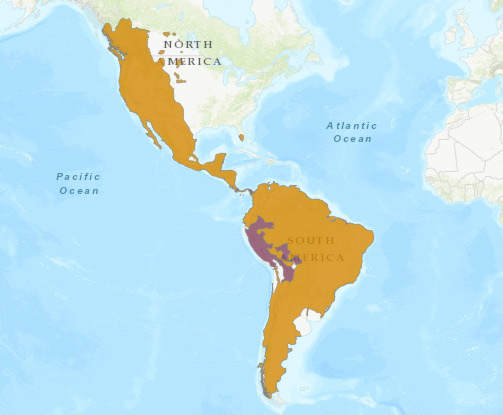Puma
Puma concolor
©Adriano Gambarini
Taxonomy
Standard English Name
Montain lion, Puma, Cougar
Scientific Name
Puma concolor
Brazilian common name/s
Onça-parda, Onça-vermelha, Suçuarana, Leão-baio
Conservation status - IUCN
Physical Description
The puma is the most widely distributed felid in the Americas. It occurs from south-western Canada to the Straits of Magellan on the southern tip of Argentina and Chile. It’s an animal that adapts to various environments, from hot deserts to Andean highlands and is also found in both tropical and temperate forests.
It has a soft coat, with a sandy- brownish colouration all over the body except the ventral region that is clearer. Cubs are born with black spots and blue eyes. The size and weight varies with geographic region, with weights ranging from 35 to 70kg. Pumas have an elongated, even delicate form that makes this species very agile. They can jump off the ground to a height of 5.5 m in a tree in a single bound.
Ecology and Habitat
They are solitary and territorial, with increased activity at dusk and during the night.
Just like the jaguar, pumas feed on wild animals of all sizes, exerting a vital role in maintaining the integrity of the ecosystems where they occur.
Couples meet only during the reproductive period. Gestation lasts 91 to 95 days, with litters of 1 to 4 cubs that become independent at 1.5 years of age.
Threats and Conservation
Hunting, habitat alteration and consequent reduction in food availability are the main threats to the survival of the puma, which is classified by IBAMA as threatened with extinction.
Online links
IUCN redlist (http://www.iucnredlist.org) presents a synthesis of current knowledge about distribution and conservation status.
IUCN Cat Specialist Group:
http://www.catsg.org/catsgportal/20_catsg-website/home/index_en.htm
IUCN Cat Specialist Group species accounts:
http://www.catsg.org/catsgportal/cat-website/20_cat-website/home/index_en.htm
References
To learn more, see the bibliography below. Pró-Carnívoros does not provide this material, except where indicated.
Oliveira, TG & Cassaro, K. 1999. Identification Guide of Brazilian felines (in Portuguese). 2nd ed. Zoological Society of Brazil, São Paulo, SP. 60p. [Can be purchased at the products link]
Brito, Bernardo Ferreira Alves. 2000. Ecologia Alimentar da onça-parda, Puma concolor na Mata Atlântica de Linhares, Espírito Santo, Brasil. Dissertação de Mestrado – Universidadde de Brasília – Programa de Pós-graduação em Ecologia.
Caso, A., Lopez-Gonzalez, C., Payan, E., Eizirik, E., de Oliveira, T., Leite-Pitman, R., Kelly, M., Valderrama, C., & Lucherini, M. (2008). Puma concolor. In: IUCN 2010. IUCN Red List of Threatened Species. Version 2010.2. , , Downloaded on 08 July 2010.
Currier, M. J. P. (1983). Felis concolor. Mammalian Species, 200, 1-7.
Emmons, L. H., & Feer, F. (1997). Neotropical rainforest mammals: a field guide. Chicago: University of Chicago Press.
Farrell, L. E., Romant, J., & Sunquist, M. E. (2000). Dietary separation of sympatric carnivores identified by molecular analysis of scats. Molecular Ecology, 9, 1583-1590.
Grigione, M. M., Beier, P., Hopkins, R. A., Neal, D., Padley, W. D., Schonewald, C. M., & Johnson, M. L. (2002). Ecological and allometric determinants of home-range size for mountain lions (Puma concolor). Animal Conservation, 5, 317-324.
Husseman, J. S., Murray, D. L., Power, G., Mack, C., Wenger, C. R., & Quigley, H. (2003). Assessing differential prey selection patterns between two sympatric large carnivores. Oikos, 101, 591-601.
Michalski, F., & Peres, C. A. (2005). Anthropogenic determinants of primate and carnivore local extinctions in a fragmented forest landscape of southern Amazonia. Biological Conservation, 124, 383-396.
Michalski, F., Boulhosa, R. L. P., Faria, A., & Peres, C. A. (2006). Human-wildlife conflicts in a fragmented Amazonian forest landscape: determinants of large felid depredation on livestock. Animal Conservation, 9, 179-188.
Nunez, R., Miller, B., & Lindzey, F. (2000). Food habits of jaguars and pumas in Jalisco, Mexico. Journal of Zoology, 252, 373-379.
Ripple, W. J., & Beschta, R. L. (2006). Linking a cougar decline, trophic cascade, and catastrophic regime shift in Zion National Park. Biological Conservation, 133, 397-408.
Romero-Muñoz, A., Maffei, L., Cuéllar, E., & Noss, A. J. (2010). Temporal separation between jaguar and puma in the dry forests of southern Bolivia. Journal of Tropical Ecology, 26, 303-311.
Scognamillo, D., Maxit, I. E., Sunquist, M., & Polisar, J. (2003). Coexistence of jaguar (Panthera onca) and puma (Puma concolor) in a mosaic landscape in the Venezuelan llanos. Journal of Zoology, 259, 269-279.
